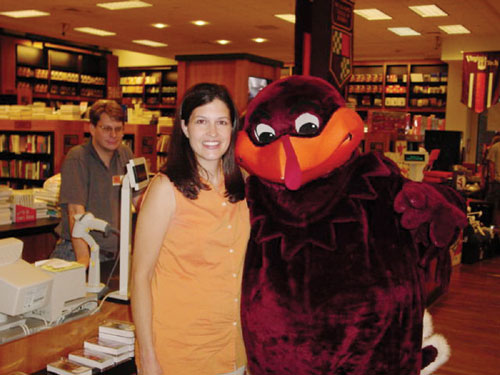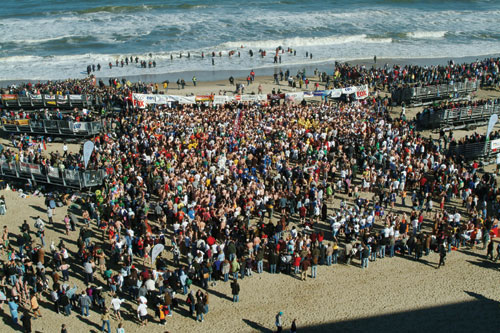|
||
|
||
|
"We've heard of children taking their mascot books to school and sharing with their class," Aryal says. "One mother even told us her child sleeps with his mascot book under his pillow." The book enchants alumni and adult fans as well. "Older alumni enjoy the journey around campus and have fun reminiscing about their days at Tech," says Aryal. “I know of a lot of people who give the book to expecting parents or grandparents, to newlyweds as a wedding gift, and to students who are graduating from Tech." On the heels of the success of Hello Hokie Bird, Aryal and her husband, Naren (finance '92), formed a publishing company, Mascot Books, and have produced books about other university mascots. Each follows a storyline similar to Hello Hokie Bird and showcases the school's mascot, along with its traditions and its most familiar landmarks. Aryal, who had no previous experience writing children's books, was surprised by the reception she received. "Initially, I was only hoping to publish a book that my daughter would enjoy," she says. "I thought it would sell enough copies to enable us to recover our printing costs. Now it seems that we stumbled upon a nice niche market, and we have been able to turn our little hobby into a real business." A nice market, indeed. At the end of 2004, Mascot Books had 40 titles in print, and the company plans to release another 50 titles in 2005, including a series of Mascot Books for NBA teams, as well as a book featuring Miles, the Marine Corps Marathon mascot. To browse Mascot Books online, visit http://www.mascotbooks.com/. |
||
|
 |
Swimming the English Channel is considered the open-water distance equivalent of scaling Mt. Everest. In September 2004, Ron Collins (business '85) reached that pinnacle, crossing from Dover, England, to Cap Gris-Nez, France, and gaining both instant membership into an elite group of athletes and a place in history. A self-described average swimmer from Tabb, Va., and a walk-on for the Virginia Tech swim team, Collins didn't always dream of such heroics. "Tubing and caving were about as adventurous as I got during my college years," he admits. "My last couple of years at Tech were mostly focused on studies just so I could make it to graduation." After graduating, however, Collins joined a United States Masters Swimming team in Florida and began training for long-distance events. In 1998, he was the first person to swim the 24-mile Tampa Bay and, two years later, was the men's champion in the Manhattan Island Marathon Swim. It was then that friends began to urge him to take on the channel, a feat that would set him apart as a marathon swimmer. |
| To prepare for the channel crossing, Collins simply continued to swim with his team. He also swam at Clearwater Beach, Fla., in winter water temperatures of 58 to 64 degrees F. The practice was essential, for when Collins entered the channel at 3:15 a.m. on Sept. 5, the water was only 64 degrees F with swells reaching two to three feet.
Still, while the conditions were harsh, the mental challenge proved to be the swimmer's greatest obstacle. "The hardest part of the day was around the 10-hour mark when I realized that the French shoreline was still not in sight and I had to swim several more hours," Collins admits. "Mentally, I was prepared for a nine-hour swim, but it eventually took 14 hours and seven minutes." Now that he has conquered the channel, Collins is seeking out his next challenge. In the meantime, he serves as the race director for the Tampa Bay Marathon, owned and operated by his company, Distance Matters Inc., which specializes in network services, Web design, software engineering, and administration of projects such as the Tampa Bay event. "Much of my business has been generated through contacts made in the swimming community here in Florida," Collins explains. "Although I am open to other projects, it seems my best customers have always been swimmers." To keep pace with Ron Collins' future exploits, visit http://www.distancematters.com. |
|
|
An idea whose time is here
|
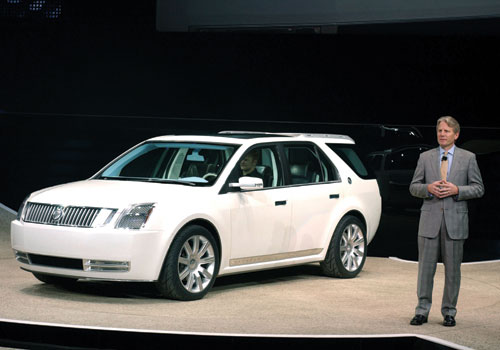 Ford Motor Company's Vice President of Product Creation Phil Martens '82 introduces the 2006 Mercury Meta One Concept at the North American International Auto Show in Detroit, Mich. |
There's much to admire about cars that operate partly on electric power, a process that minimizes exhaust emissions and maximizes fuel efficiency. Especially effective in stop-and-start city driving, hybrid vehicles are coming on strong, with this year's U.S. sales predicted to hover around 100,000. Among these new hybrids--which can save 40 percent or more on fuel--is the world's first hybrid sports utility vehicle (SUV), the virtually emission-free 2005 Ford Escape Hybrid. The brainchild of Philip R. Martens (mechanical engineering '82), a Ford vice president who oversees the design, engineering, and development of all Ford, Lincoln, and Mercury cars and light trucks created and sold in North America, the Escape Hybrid debuted last June when Ford CEO Bill Ford Jr. donated 12 of the vehicles to the National Park Foundation. The Escape Hybrid was created to confirm Ford's commitment to producing vehicles that are good for both consumers and the environment. Not only is the SUV the first American-made full hybrid, Ford can boast that it's the most fuel-efficient and "cleanest" yet marketed: in one run, the SUV was driven 576 miles in New York City on a 15-gallon tank of gas. |
| A native of Buffalo, N.Y., Martens joined Ford as an intern in product planning in 1986, after having received an M.B.A. from the University of Michigan. The exposure convinced him that he wanted a career in the automotive industry, at Ford in particular, and he has since worked through the company ranks, save a few years designing for Mazda.
"I have always had an affinity with the automobile," Martens admits. "As a kid, I built model cars and I loved the details. By about age 12, I was racing a go-cart on tracks around the Buffalo area, and I loved modifying the carts. By the time I attended Virginia Tech, I owned two motorcycles." Martens notes that he has always approached the industry from a high level. "Namely, I was attracted to how truly American an institution it is," he says. "With one in 10 U.S. jobs linked to the auto industry, I was attracted to its awesome economic responsibility. And we produce great consumer products which can nurture a society's strength and success." Such thinking has served Martens well. In January, the Escape Hybrid was named the "2005 North American Truck of the Year" at the North American International Auto Show in Detroit. The hybrid SUV has arrived. |
|
|
Puppeteer raises awareness among children
|
 Sara Qureshi '95 |
Although Sara Qureshi (theatre arts '95, Spanish '95) began her studies at Virginia Tech wanting to become an actor, the actor's life seemed less appealing as her goals changed. "I wanted my work to both fulfill me as a creative person and allow me to work somewhat regular business hours," Qureshi admits. "I learned that an actor's wacky hours and travel commitments wouldn't work for me as a person who wanted a certain kind of life--a normal family life." In great part, that desire for stability led Qureshi to her job as an educational puppeteer and curriculum developer for The Kids on the Block Inc. (KOB). Based in Columbia, Md., KOB was formed in 1977 in direct response to U.S. Public Law 94-142, the Education of All Handicapped Children Act. The act required that children with disabilities be educated in the least restrictive environment, a charge that often meant inclusion in a classroom with peers who sometimes did not understand their classmates' differences. To help these children, KOB has, over the years, developed more than 40 live theater programs presented by puppets who are living with illnesses such as cerebral palsy and leukemia, as well as dealing with other challenges that school-age children face, including learning disabilities, social issues, and multiculturalism. |
| Accompanied by a curriculum that includes answers to questions children may ask, character biographies, and extensive resource materials, these programs are made available to non-profit performance troupes at schools, community service organizations, hospitals, and special interest groups across the country.
Perhaps the most valuable aspect of each program is the period during which the children are allowed to interact with the puppets. Indeed, a show at a bereavement camp for children dealing with the loss of a parent remains a most significant moment for Qureshi. "During the question-and-answer period, children opened up to discuss things with the puppets they might not have been ready to talk about with adult bereavement counselors," she says. Moreover, after the session was over, one of the children felt confident enough to approach Qureshi, not her puppet, to share his grief. For Qureshi, experiences like this one affirm her career choice. "Knowing that what I do isn't just a fun and creative job, but has an impact on children's lives makes it all the more worthwhile." To learn more about The Kids on the Block, go to http://www.kotb.com/. |
|
|
Jump start
|
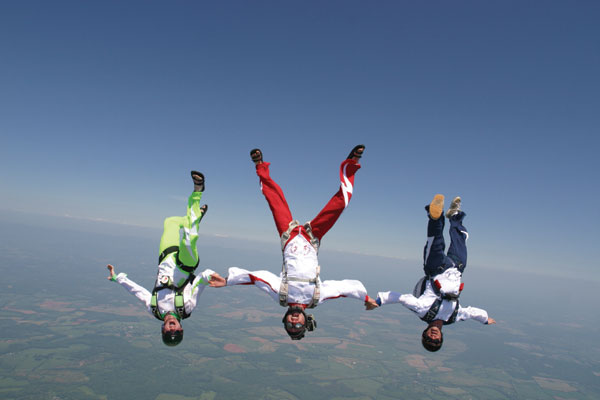 The members of Syzygy take a flying leap. |
Syzygy, among astronomers, is the nearly straight-line configuration of three celestial bodies in a gravitational system. Translated into the world of competitive skydiving, Syzygy is a winning team comprised of John Elmore (forestry '93), a commuter airline pilot; Bobby Page (statistics '94), a warfare analyst for the Joint Chiefs of Staff; and Shane McGroarty (property management '94), a property manager. In October 2004, the team made its first trip to the National Skydiving Championships in Perris, Calif., and came away with the bronze medal in the Intermediate Freeflying division, which required five rounds of jumps scored on artistry and technical ability, as well as two speed rounds that scored moves repeatedly executed during a 35-second time frame. "We wanted to just go out there, see what this whole competition world is all about, and do the jumps as good as we did them at home," says McGroarty. "The rest was up to the judges, and apparently they liked what they saw." |
| The three skydivers have only been together as a team since 2000, but their friendship dates back to their student years when both Elmore and Page served terms as president of the Virginia Tech Skydiving Club, where they met McGroarty. After graduation, Page and Elmore continued to jump in local competitions and, following the growing popularity and newly official status of competitive freeflying (in which stylized jumps featuring fluid, almost ballet-like movements are performed before a camera), formed a team called Shocker.
When one of Shocker's founding members left the team, Page and Elmore sought to fill the ranks with McGroarty, who by then jumped regularly at the Skydive Orange facility, the trio's home jumping facility in Orange County, Va. With their new teammate came the group's new name, Skydive Orange Syzygy. The freeflying trio continues to add to its more than 10,800 combined jumps and plans to return to the national competition in 2005. "We hope to get 150 jumps in this year to prepare for the 2005 U.S. Nationals, where we will compete in the Open Class," Page reports. "These will double last year's jumps." For more information on skydiving, visit the U.S. Parachute Association's website at http://www.uspa.org. |
|
|
Three more Hokies lost in the war in Iraq
|
 |
On Dec. 21, Spc. Nick Mason, a member of the Virginia Army National Guard 229th Engineer Company, was killed in the suicide bombing of a cafeteria tent at Forward Operating Base Marez, near Mosul, Iraq. A 2002 graduate of King George High School, Mason was a student at Virginia Tech until his National Guard unit deployed in 2003. Army Staff Sgt. Nathaniel Nyren, a student at Virginia Tech from August 1991-December 1992, was killed in Iraq on Dec. 28, when his vehicle was struck by a car driven by an Iraqi teenager. Nyren was a member of the Army's 1st Battalion, 8th Cavalry Regiment, 1st Cavalry Division. He was buried at Arlington National Cemetery with military honors on Jan. 10. Marine Corp. Christopher L. Weaver (history '02), a member of the Marine Corps Reserve's Company C, 4th Combat Engineer Battalion, was killed on Jan. 26 when insurgents attacked his patrol as it traveled back to base. He is the fifth member of the Virginia Tech community to die in the conflict in the Middle East. |
|
Is blue one of Tech's new colors?
|
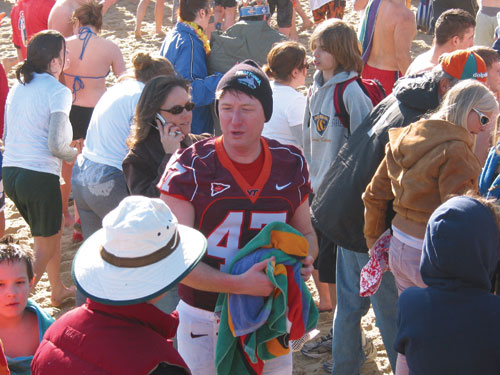 |
|
|
The 13th Annual Polar Plunge in Virginia Beach, Va., to benefit Special Olympics Virginia
|
|
|
Coach Frank Beamer honored by Virginia General Assembly
|
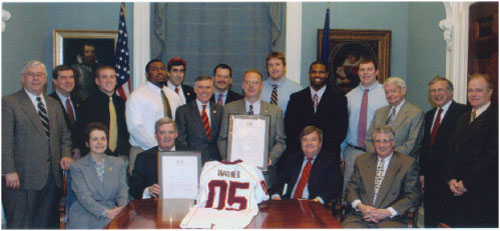 Coach Frank Beamer (seated, second from left) and members of the football team were honored, respectively, as the ACC Coach of the Year and as ACC champs by General Assembly members who graduated from Virginia Tech or are otherwise affiliated with the university. Among those in attendance were: (standing, far left) Rep. David Nutter (political science '79); (standing, fifth from left in back) Del. Glenn Oder (landscape architecture '80); (seated, second from right) Del. Jim Shuler (animal science '66); (standing, third from right) Del. Harry Parrish (business administration '44); (seated, far right) Del. Tom Rust (civil engineering '65); (standing, second from right) President Charles Steger (architecture '69); and (standing, far right) Del. Allen Louderback (business administration '70). Coach Frank Beamer (seated, second from left) and members of the football team were honored, respectively, as the ACC Coach of the Year and as ACC champs by General Assembly members who graduated from Virginia Tech or are otherwise affiliated with the university. Among those in attendance were: (standing, far left) Rep. David Nutter (political science '79); (standing, fifth from left in back) Del. Glenn Oder (landscape architecture '80); (seated, second from right) Del. Jim Shuler (animal science '66); (standing, third from right) Del. Harry Parrish (business administration '44); (seated, far right) Del. Tom Rust (civil engineering '65); (standing, second from right) President Charles Steger (architecture '69); and (standing, far right) Del. Allen Louderback (business administration '70). |
|||||||||||||||
|
We want to know…
|
|||||||||||||||
|
